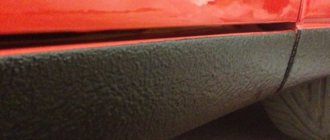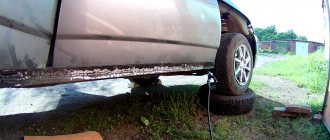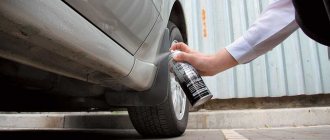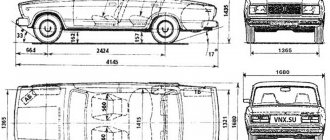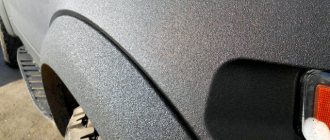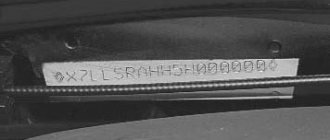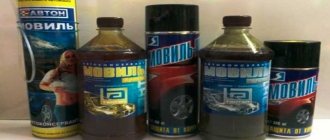Wear and tear of a car as it is used is a completely natural and natural phenomenon. All kinds of obstacles and factors negatively affect the condition of the vehicle.
Quite often, it is the body that suffers because it encounters road dust, debris, gravel, etc. The result is chips, scratches and damage to the paintwork.
Thresholds are also among the vehicle's vulnerable points. They are constantly in contact with shoes, the soles of which may contain abrasive particles (sand, dirt, debris), various types of chemicals used in winter, and more. Thresholds also wear out, wear out and get scratched.
But it is within the power of the motorist to protect them by covering the thresholds with a protective film. This is a fairly effective protective agent available to everyone.
The concept of armored film
If you want to focus specifically on protecting the thresholds, then you will need to use special protective material.
Many people quite often associate armored film with vinyl film, which is used to cover car sills. But these are not exactly the same materials. Vinyl is more of a decorative coating, since its strength is noticeably lower than that of a polyurethane coating.
There is also a carbon type of film, but only some varieties have sufficient protective properties. Most of them are for indoor use only and are not suitable for external use.
Armor film is a transparent anti-gravel film that effectively protects all the most vulnerable areas of the body. It does not in any way affect the change in appearance, maintaining the original color of the threshold. But at the same time it covers it with a protective, durable layer.
Pasting the thresholds with a special high-quality anti-gravel film allows you to significantly increase the level of protection of the paint layer from all kinds of damage, from ordinary dirty shoes to sharp women's heels and small mechanical impacts on the coating.
How to put protective film on car sills
The body is the most expensive part of the car. When a used car is put up for sale, the buyer, first of all, pays attention to ensuring that the body is intact. From physical impact, for example, from shoes, the top paint coating on the threshold of the car can wear down to metal. Because of this, some problems arise, such as corrosion and the spread of rust to other parts of the body.
However, not only the internal part of the threshold can suffer, but also the external one. This occurs due to the physical impact of various particles that fly off the road surface while driving. Sand, gravel, stones and other things cause scratches and chips on the thresholds.
What are the main advantages
If you still doubt whether you need film to protect your car's sills, you should take a look at the main advantages of such a solution.
First you need to understand how armored film made on the basis of polyurethane prevents damage to the paintwork. This is due to the properties of the material to dissipate energy when striking. Therefore, polyurethane is widely used to protect the most vulnerable areas of a car, including headlights, hood and sills.
In addition to mechanical protection, the thresholds are protected from infrared radiation. Together with it, protection is created from UV rays and aggressive chemicals that are actively scattered along Russian roads during winter precipitation.
If you have a new car and you bought it literally before the start of winter, then this is a good reason to stick the film on. It will protect the paintwork and preserve the original appearance of the car. As the coating wears out, it is simply removed and replaced with a new one.
What car seats need to be booked?
Car armoring with film does not imply complete wrapping of the car, but on the contrary, it is intended for local application to certain places - those that are most susceptible to impacts and mechanical damage. These include:
- the hood is its central part;
- windshield;
- radiator and bumper;
- headlights and mirrors;
- thresholds, door handle areas.
It is imperative to use PTF film armoring, as well as conventional headlights, since the functionality of the coating provides double protection. In addition to eliminating mechanical damage, the possibility of cracking after impact is completely eliminated.
Additional protection is also necessary in places where abrasions from constant contact occur over time, such as door handles, sills, and bumpers.
What you need for work
Each manufacturer may have its own recommendations regarding the use and application of protective films for sills and other areas of the car body.
But most of them have common principles and the same approach to organizing the process. If you cover the thresholds of your car with armored transparent film yourself, you will first have to collect a list of necessary tools and materials.
To work, you basically need a set consisting of:
- the armoring transparent film itself;
- paper for cutting blanks (if the shape of the threshold is complex);
- rubber spatula;
- stationery knife;
- sharp scissors;
- water sprayer;
- detergent;
- dry, clean, lint-free rags.
Professionals quite often use the dry method, which does not involve the use of a soap solution. But for this method you need a fairly powerful construction hairdryer.
When gluing yourself, the dry method is not recommended. It requires extreme precision, experience and skill. A beginner may not be able to cope with this, and correcting the error will be quite difficult. You'll have to redo everything again. Therefore, the main emphasis will be on the wet method.
Preparatory stage
To cover the surface of a car with an anti-gravel sticker, do the following:
- Wash and then degrease the surface. A weak alcohol solution is suitable for degreasing.
- Try the film on the surface where you plan to stick it. You can use masking tape to mark the boundaries. When trying on, do not remove the paper backing from the sticker, otherwise you risk ruining the material. After trying on, cut out a piece of film of the size and shape you need.
Try the film on the surface where you plan to stick it.
Next, you will need to decide which type of pasting suits you best. There are two methods by which you can paste a car: dry and wet.
The advantage of the dry method involves getting rid of air bubbles due to the presence of air channels in the sticker, which allows you to apply it to a clean surface. The disadvantage of this method is the inability to change the location of the material. Pasting a car is possible only once, and if you apply the material crookedly, you will not be able to move it.
Another method of gluing anti-gravel coating is wet, which consists of first applying a soap solution to the car, which, on the one hand, promotes the adhesion of the material, and on the other, makes it possible for it to move along the surface of the car. Often a primer is used before wet pasting.
Preliminary preparation
The mistake of most motorists who decide to independently armor the thresholds of their car with a special film is to ignore the preparatory stage of this work.
There are even those who simply brush off a layer of dust from the threshold and immediately begin gluing the material. As a result, approximately the same subsequent picture occurs. After a while, the film begins to peel off, air bubbles form under it, it quickly breaks and only spoils the appearance of the car.
In order to correctly apply a previously purchased protective film to the thresholds of your own car, you must first complete the required preparation. It consists of several stages:
- If the car has been in service for more than one year, the paintwork could become damaged and begin to peel off. It is better to immediately protect these places, paint them and varnish them.
- If the configuration of the thresholds is quite complex, some dismantling may be required to get to hard-to-reach places.
- The thresholds are washed and dried very carefully. It is advisable to blow out all the cracks and gaps with compressed air so that there is no moisture under the film.
- After drying is complete, use any product with degreasing properties. Make sure it will not damage the paintwork.
- The thresholds will probably have places where the film is bent. It is recommended to treat these areas with a primer.
Advice from professionals
- Reserving thresholds with protective film is best done with two people; an extra pair of hands never hurts.
- When heating the protective film with a hairdryer, be careful not to melt it.
- When purchasing protective film for car sills, it is better to focus on well-known manufacturers. Which produce high-quality and reliable protective film.
- To protect car sills, you must purchase a protective film with a thickness of at least 250 microns.
- We also recommend reading the articles on our website “Carbon film for a car” and “Do-it-yourself glass tinting”. Carbon film can also perfectly protect the car from various damages.
Pasting thresholds
When the preparatory stage is completed, the thresholds themselves are directly covered with a high-quality protective film. This task can be done with your own hands.
- First of all, make the necessary patterns. To do this, the armored film is applied to the surface of the thresholds, fixed with tape, and outlined with a marker or pencil. Then it is removed and cut out. At this stage, it is too early to remove the protective layer from the film.
- For the wet method you will need a sprayer. A device like the one used to spray houseplants is suitable.
- Pour clean water into the container and add a few drops of detergent. Mix thoroughly. The soap solution is ready.
- Apply this solution to the first threshold to be glued using a sprayer.
- Carefully, being careful not to leave fingerprints, remove the protective layer from the armor film.
- Glue the material approximately in the center of the threshold.
- Moving from the center to the edges, using a spatula or squeegee, carefully begin to smooth out the film.
- Make sure that there are no air bubbles left under the film. Take your time, gradually smoothing the material and removing the soap solution from under it.
- At the bends, it is recommended to warm up the film a little using a household hair dryer.
- The edges themselves on the side of the adhesive coating can be lightly treated with a primer to achieve better adhesion.
- The bends on the uneven surfaces can be heated a little more, and then they will go away.
- When the material is completely distributed over the threshold, go over the entire surface with a hairdryer. But don't overheat the material.
If you are using a carbon type film, you must warm it up before applying it.
It is advisable to leave the car in a garage at a stable temperature and low humidity for a day. After this, you can safely begin your usual daily use of the car.
How long the film will last depends on several factors simultaneously. In any case, this is better than leaving the thresholds without protection at all.
Bottom line
Thus, armoring car windows with film protects very well not only from foreign objects flying from under the wheels, but also from possible robbers and vandals. But, as a rule, car owners begin to think about it only when something like this happens and the glass is damaged.
- Next Alternator belt whistles: what to do and how to fix it
- Back Removable tinting: what it is and how to use it
- News / Ratings
Oct 3, 2019
- Oct 3, 2019
- Oct 2, 2019
- 1 Oct, 2019
- BMW Crossovers / News
Sep 30, 2019
- Sep 30, 2019
- April 13, 2019
- March 12, 2019
- Feb 17, 2019
- News/Reference information
Jun 22, 2019
- April 11, 2019
Popular crossovers
Acura crossovers Audi crossovers BMW crossovers Cadillac crossovers Chevrolet crossovers Chery crossovers Citroen crossovers Dodge crossovers Ford crossovers Honda crossovers Infiniti crossovers Jeep crossovers Hyundai crossovers Kia crossovers Lexus crossovers Lada crossovers Land Rover crossovers Mazda crossovers Mercedes crossovers Mini crossovers Mitsubishi crossovers Nissan crossovers Porshe crossovers Peugeot crossovers Crossovers Opel Crossovers Renault Crossovers Ssang Yong Crossovers Skoda Crossovers Subaru Crossovers Suzuki Crossovers Toyota Crossovers Volkswagen Crossovers Volvo Crossovers
Features of film fastening
The film is attached to a special soap solution. One of the options would be to use Johnson's Baby shampoo or Fairy dishwashing liquid as a basis, since these products do not contain alkali. Some pasters use ordinary water, but a soap composition will help the material not stick, and even if a wrinkle forms, it can easily be corrected or re-rolled.
Depending on the manufacturer, prices will fluctuate. Several main representatives on the polyurethane film market in Russia are:
- Venture Shield.
- Suntek.
- Hexis.
The quality of Venture Shield armor films has become much worse recently. Suntek is the best armor film for car glass because the material is the most transparent and strong. Some types of Suntek material will be able to withstand a direct hit from a machine gun bullet. Hexis has a pretty good quality/price ratio.
Development Director of Re-Styling Ivan Kovalev
Beware of fakes
We recommend purchasing armored film only from official representatives in automotive stores. Check the certificates of conformity, expiration date and storage rules for the material.
On the market and online classifieds sites, counterfeits are often sold, which are passed off as genuine products from well-known manufacturers. We advise you not to take such goods “from hand to hand” through friends. After all, you run the risk of covering your car with a low-quality coating that will not protect its body from damage, but rather ruin it.

